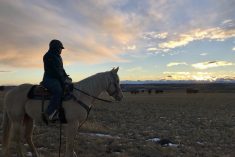DEHORNING/ CASTRATION
Dehorning
The ideal solution is to buy cattle without horns. But that isn’t always possible. Incoming cattle may be dehorned during or after processing, depending on conditions at the time.
Recommendedprocedures
Ensure staff is trained in the proper use and method of the dehorning equipment you use, whether it be gouge, saw or wire.
Ideally, clip hair and clean off the base of the horn if it is dirty.
Read Also

Reintroducing fire to Saskatchewan pastures
Pastures evolve over time. Woody plants and shrubs, which cattle can’t eat, may encroach on natural grasses. Invasive species, such…
Do a quick, neat job — do not gouge too deep if using a horn gouge.
In the case of yearlings or animals with large horns where significant bleeding may occur, apply rubber bands to the base of the horns to encourage faster blood clotting. These bands can be removed within 24 hours.
In the case of small, weaned calves with stub horns, cut the horns off close to the head and consider cauterizing the horn base with a heated dehorning tip to stop any blood flow.
Ensure dehorning equipment is sanitized after each animal has been dehorned and change disinfectant solution as appropriate.
Move cattle to holding or hospital pens where they can be monitored and brought back in 24 hours to have the bands removed.
Dehorning is a weather-sensitive procedure. Cold, wind, dirt and flies are factors to consider when deciding to dehorn.
Check for fractured or loose bone before releasing the animal from the chute. Record any horn infections and monitor the incidence. Develop a treatment protocol to deal with horn infections.
Maintain your dehorning equipment and keep in good condition.
Indicatorsofproblems
Excessive number of horned cattle in the feeding pens.
Significant number of horn and sinus infections to be treated after dehorning.
Critical indicator:excessive death losses from dehorning complications.
Castration
Once again, the easiest method for the feedlot operator is to purchase steers that are properly castrated. When intact males do arrive, castration using recommended operating procedures can reduce the incidence of staggy cattle (grade E) and dark cutters (grade B4) which are discounted down to cow prices. Fighting among bullers is also lessened which reduces the bruises and injuries that come out of the pens. A Quality Starts Here audit calculated that proper castration could reduce losses to $31 to $37 per head.
The guidelines below apply to bloodless and surgical castration techniques.
Ensure your staff is trained in the correct use of the equipment and use the proper technique. This seems like such an obvious suggestion but it is one that is too often overlooked.
When using the surgical method, ensure sufficient pressure is applied to stop blood flow for at least one minute on small calves, and increase the amount of time as the size of the testicle increases, up to three minutes on large calves. Be familiar with the “nut-to-nut” technique, whereby the nut on the emasculators should face the testicle on the bull. Proper technique is your best defense against post-castration infections and death from blood loss.
Ensure the castration site, handlers’ hands and castration equipment are clean when using the surgical technique. Use an antiseptic recommended for animals such as Betadine. Clean equipment between animals and keep the disinfecting solution clean by changing it as needed.
Keep equipment properly maintained and in good working order. In other words, make sure your knives are sharp, and the emasculator still exerts enough crushing pressure to do a clean job.
Ensure bloodless tubing is stored properly. It can be ineffectual if exposed to light for long periods of time. The tubing can dry out, get old, and then may break, or stretch, and not hold.
Check vaccination history to ensure the cattle are immunized against tetanus before you castrate them.
Have a protocol in place to deal with castration infections and record the incidence as a means of monitoring the success of your technique.
Have a procedure in place set up by your veterinarian to handle the surgical removal of belly nuts.
Indicatorsofproblems
Large numbers of bullers in the pens.
Excessive number of purchased steers that are bulls. (This may indicate a problem with the cattle buyer, or improper order and should be priced accordingly.)
Excessive number of grade E (staggy) carcasses or grade B4 (dark cutters) showing up on the grading sheets.
Critical indicator:Excessive post-castration complications.
Thefollowingrecommendedpracticesshouldbeconsideredwhencrewsneedtodehornorcastratefeedercattleenteringthelot.















